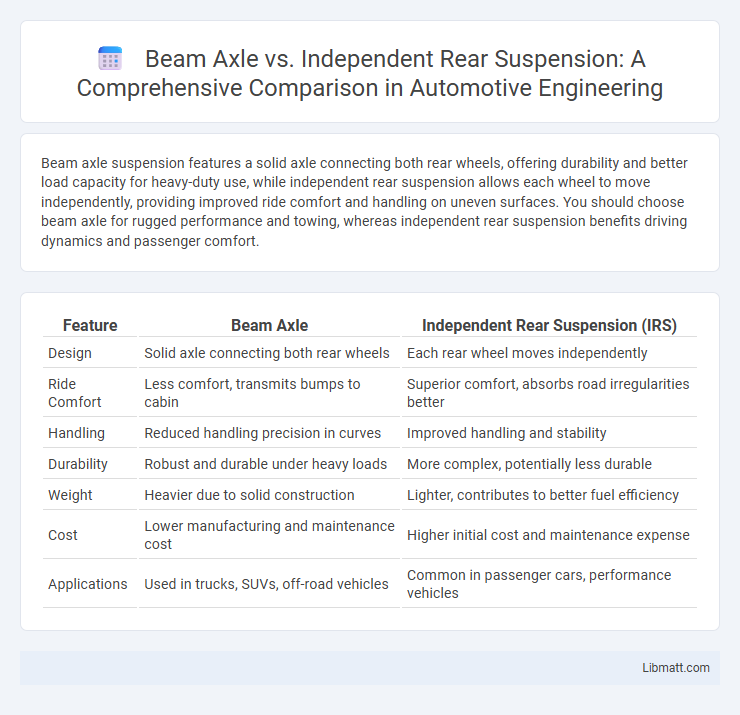Beam axle suspension features a solid axle connecting both rear wheels, offering durability and better load capacity for heavy-duty use, while independent rear suspension allows each wheel to move independently, providing improved ride comfort and handling on uneven surfaces. You should choose beam axle for rugged performance and towing, whereas independent rear suspension benefits driving dynamics and passenger comfort.
Table of Comparison
| Feature | Beam Axle | Independent Rear Suspension (IRS) |
|---|---|---|
| Design | Solid axle connecting both rear wheels | Each rear wheel moves independently |
| Ride Comfort | Less comfort, transmits bumps to cabin | Superior comfort, absorbs road irregularities better |
| Handling | Reduced handling precision in curves | Improved handling and stability |
| Durability | Robust and durable under heavy loads | More complex, potentially less durable |
| Weight | Heavier due to solid construction | Lighter, contributes to better fuel efficiency |
| Cost | Lower manufacturing and maintenance cost | Higher initial cost and maintenance expense |
| Applications | Used in trucks, SUVs, off-road vehicles | Common in passenger cars, performance vehicles |
Introduction to Rear Suspension Systems
Rear suspension systems are crucial for vehicle stability and ride comfort, with beam axles offering a solid, durable connection between the rear wheels that excels in heavy-duty and off-road applications. Independent rear suspension provides improved handling and ride quality on uneven surfaces by allowing each wheel to move independently, reducing unsprung weight and improving traction. Understanding the differences helps you choose the ideal setup based on your driving needs and terrain.
What Is a Beam Axle?
A beam axle is a solid rear suspension system where both wheels are connected by a single rigid beam, providing durability and simplicity, especially in off-road and heavy-duty vehicles. This design maintains consistent wheel alignment under load but can compromise ride comfort and handling compared to independent rear suspension systems that allow each wheel to move independently. If you prioritize robustness and load-bearing capacity over ride quality, a beam axle setup suits your vehicle's rear suspension needs.
What Is Independent Rear Suspension (IRS)?
Independent Rear Suspension (IRS) allows each rear wheel to move independently, improving ride comfort and handling by reducing road shock and maintaining better tire contact with the road. Unlike a beam axle where both wheels are connected by a solid axle, IRS uses components such as control arms, trailing arms, and coil springs to isolate wheel movement. This design enhances traction and stability, especially on uneven terrain or during cornering, making it a preferred choice for modern performance and luxury vehicles.
Key Differences: Beam Axle vs Independent Rear Suspension
Beam axle suspension features a solid, single-piece axle that connects both rear wheels, providing durability and simplicity ideal for heavy loads and off-road conditions. Independent rear suspension allows each wheel to move independently, improving ride comfort, handling, and traction on uneven surfaces by minimizing wheel interference. Key differences include ride quality, with independent suspension offering superior control and stability, while the beam axle excels in strength and cost-effectiveness.
Ride Comfort and Handling Comparison
Beam axle suspensions offer durability and load-bearing strength but often result in a stiffer ride with less precise handling due to the solid connection between wheels. Independent rear suspensions improve ride comfort by allowing each wheel to react separately to road irregularities, enhancing traction and cornering stability. Your driving experience benefits from smoother rides and better handling performance, especially on uneven terrain or during dynamic maneuvers with independent setups.
Performance and Stability Factors
Beam axle suspension offers robust durability and consistent wheel alignment, enhancing performance on rough terrains and heavy loads. Independent rear suspension improves stability by allowing each wheel to move independently, resulting in better handling, ride comfort, and traction on uneven surfaces. Your choice impacts vehicle dynamics, with beam axles favoring rugged stability and independent systems optimizing agility and road grip.
Durability and Maintenance Considerations
Beam axles offer superior durability due to their simple, solid construction, making them less prone to damage from heavy loads and rough terrain. Maintenance is generally easier and less frequent since fewer moving parts and simpler geometry reduce wear and tear. Independent rear suspension systems provide enhanced ride comfort and handling but require more complex components, leading to higher maintenance costs and potential for increased wear over time.
Cost Implications: Beam Axle vs IRS
Beam axle suspension systems generally incur lower manufacturing and maintenance costs due to their simpler design and fewer moving parts. Independent rear suspension (IRS) demands higher production expenses given its complex components and enhanced engineering requirements for improved ride comfort and handling. Consequently, vehicles with beam axles offer budget-friendly solutions, whereas IRS-equipped models are often positioned in higher price brackets reflecting advanced suspension technology.
Common Applications and Vehicle Types
Beam axles are commonly found in trucks, SUVs, and off-road vehicles due to their durability and ability to handle heavy loads and rough terrain. Independent rear suspension is typically used in passenger cars, sports cars, and luxury vehicles to provide improved ride comfort, handling, and traction. Your choice between the two often depends on whether you prioritize ruggedness and load capacity or enhanced driving dynamics and road comfort.
Which Rear Suspension Is Right for You?
Choosing between a beam axle and independent rear suspension depends on your driving needs and preferences. Beam axle systems offer durability and load-carrying capacity ideal for off-road and heavy-duty vehicles, while independent rear suspension provides better handling, ride comfort, and improved traction on uneven surfaces. Your decision should consider whether you prioritize ruggedness and simplicity or enhanced ride quality and cornering performance.
beam axle vs independent rear suspension Infographic

 libmatt.com
libmatt.com